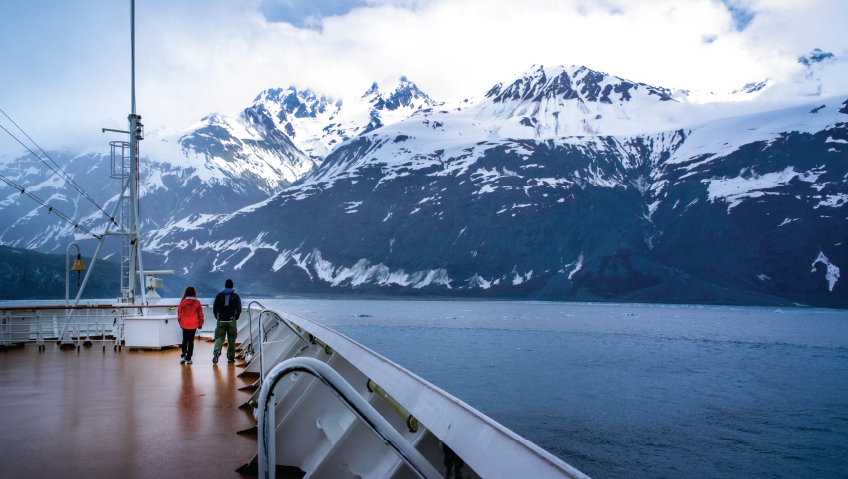While the world has been inundated with repeated warnings regarding the effects of climate change if world leaders fail to limit warming to 1.5 degrees Celsius over the next 43 years, we’re already experiencing several devastating shifts. Along with record-breaking heat waves and turbulent storms, climate models predict the Arctic will see significant and ongoing sea ice reductions, with almost no ice present during the summer by the middle of the 21st century, according to the Canadian Mining Journal.
Although the Arctic Ocean’s future is bleak as a result of the world’s oceans being quickly warmed by climate change—many species that are adapted to extremely cold temperatures will be threatened by the Arctic’s changing environment, according to scientists—an additional crucial outcome of Arctic ice melt is the possibility of taking detours from the Russian-controlled Northern Sea Route to shorter, more environmentally friendly marine trade routes.
According to a 2022 study by Finnish and Norwegian scientists, the Arctic region has warmed four times faster than the rest of the world over the previous 40 years and it is estimated that by 2035, sections of the Arctic may experience summertime conditions. This development in turn will provide opportunities for commercial shipping to operate in these seas and reduce passage times between the United States, Europe, and Asia, according to The Bradley Intelligence Report in August 2023.
The passage time for Arctic routes could be shortened by up to 50 percent compared to Suez and Panama Canal routes, saving an estimated 14 to 20 days, drawing both adventure travellers and cruise ships in addition to commercial shipping companies.
Since the Soviet Union initially opened the Northern Sea Route (NSR) in the 1930s, ice cover has prevented the route from being a dependable travel route. That is changing due to climate change, but not without pushback. Russia asserts that the NSR is within its territorial seas, granting it the sole authority to build infrastructure and deploy patrol boats there, a claim disputed by the U.S. and other nations, who say that it passes through international waters. Russia has been renovating over 50 Soviet bases, giving them strategic ports and delivering a political message that the NSR is under Russian authority.
The Northwest Passage (NWP), according to Canada, is situated in its internal waters and is governed by its sovereignty and laws. Europe and the United States disagree, claiming the Law of the Sea grants freedom of navigation over this international waterway as well. There aren’t many ports along the NWP yet; the sole deep-water port with berthing and shelter is the Port of Churchill in Hudson Bay.
Neither the Canadian Archipelago nor the North Slope of Alaska have any deep-water ports. However, things are evolving, with the first deep-water Arctic port to be built by the United States at Nome, Alaska. Meanwhile, Canada intends to develop a deep-water port at Qikiqtarjuaq, Nunavut, which is situated at the entrance of the Northwest Passage.
The Trans-Arctic Route, which crosses the North Pole directly, stays out of Arctic state territorial waters and travels across international high seas. At present, and likely until the middle of the century, only nuclear icebreakers can cross it. However, the possibilities are being addressed with a hub at Alaska’s Dutch Harbour, with thousands of ships moving between North America and Asia annually. Since the depth of the Central Arctic Ocean is not as restricted as it is in the NSR and NWP, there would be no size limits for the ships.
A study from Brown University from June 2022, The interaction of ice and law in Arctic marine accessibility, has also projected how shipping route regulation may change in the next decades as a result of Arctic Ocean ice loss. According to their predictions, the Arctic could become so much more navigable that it may open up new trade routes in international waters, which would reduce the carbon footprint of the shipping sector and undermine Russia’s monopoly on commerce in the region.
The United Nations Convention on the Law of the Sea has granted Arctic coastal states more control over major maritime lanes since 1982. According to Article 234 of the convention, nations whose coastlines are close to Arctic shipping routes have the authority to regulate the route’s maritime traffic in the name of “the prevention, reduction and control of marine pollution from vessels,” provided that the region is mostly covered in ice.
Russia has been using Article 234 for its own geopolitical and economic purposes for decades. According to a Russian law, Russians must operate all ships that travel the Northern Sea Route, while passing vessels must pay tolls and notify the nation in advance of their intentions to use the route.
Due to the many rules and high prices, major shipping firms frequently utilize the longer, easier, and less expensive Suez and Panama Canal trade routes, but as the ice melts, shipping will shift from Russian territorial waters into international waterways.
And given the growing number of free trade agreements between China and Russia, there is little doubt this corridor has substantial future investment potential, according to the 2023 Canadian Mining Journal article, What future for shipping in the Arctic region? China has made significant financial investments in the Russian Arctic economy, extending beyond the booming oil and gas industry in the area. The Northern Sea route is expected to become a major worldwide maritime route for goods travelling from Asia to Europe and vice versa, something Beijing’s officials are well aware of. In response to the significant prospects that it and China perceive, Russia has declared the entire area to be a “free trade zone,” as defined by Russian national legislation.
While increased shipping zones may be good for business, they will also absolutely impact those who live in the affected areas. According to The Arctic Council, coastal populations in the Arctic—which are accustomed to mainly un-trafficked waters—are anticipated to undergo significant changes. Growing shipping may make it more difficult for communities to collect fish and marine mammals for their livelihood, contaminate beaches with fuel or other hazardous materials, or place a significant strain on their already-limited search and rescue and emergency response capabilities.
One such settlement is the town of Adak, which is situated in the Aleutian Islands, which link the Russian Kamchatka Peninsula with the Alaska Peninsula to the west. The quicker route to Europe may become profitable for routes to Japan, Korea, and China if the Northern Sea Route is navigable for more than half the year. The 330-person town of Adak may soon find itself in the path of Arctic shipping, which will link ships to the Great Circle Route, which 7,000 ships may eventually utilize to transport cargo to Europe.
Safe and sustainable shipping is also essential for the Unangan (Aleut people) and other Indigenous peoples who depend on subsistence hunting along the Arctic coastline. Since this developing maritime industry has the potential to have a huge impact on people living in the Arctic and the region overall, coordination and cooperation between all parties involved are essential to ensure this new industry is developed in a sustainable manner.
There is certainly a lot at stake here and much to consider in a short time period. The undeniable fact of the Arctic melting means that creating plans, strategies, and agreements sooner rather than later can potentially help avoid international issues regarding new waterways. Although sea ice is not the only element that affects Arctic navigation—economics, infrastructure, bathymetry, and weather are other important considerations—these forecasts are helpful for governments, regulatory bodies, and the international marine sector in their strategic planning. The loss of Arctic ice in the decades to come is devastating, but it also means a variety of economic, legal, environmental, and geopolitical ramifications.






